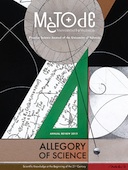Trembley's Polyp: The "animal-plant" that changed 18th century biology
DOI:
https://doi.org/10.7203/metode.78.2539Keywords:
biology, Great Chain of Being, performationism, regeneration, soul, zoology Abstract
Abstract
Abraham Trembley’s experiments with freshwater hydra not only surprised his contemporaries, but his results also caused a huge stir among the scientific community of his time. Ideas such as «The Great Chain of Being», the mechanism whereby living things were created, or the nature of the soul were strongly shaken.
 Downloads
Downloads
 References
References
BAKER, J. R., 1952. Abraham Trembley of Geneva. Scientist and Philosopher (1710-1784). Edward Arnold. London.
BYNUM, W. F., 1975. «The Great Chain of Being after Forty Years. An Appraisal». History of Science, 113: 1-28.
CARLIN, L., 2000. «Leibniz’s Great Chain of Being». Studia leibnitiana, 32: 131-150.
DAWSON, V. P., 1987. Nature’s Enigma. The Problem of the Polyp in the Letters of Bonnet, Trembley and Réaumur. American Philosophical Society. Philadelphia.
LOVEJOY, A., 1936. The Great Chain of Being. A Study of the History of an Idea. Harvard University Press. Cambridge, MA.
Moscoso, J., 1995. «Experimentos de regeneración animal: 1686-1765. ¿Cómo defender la pre-existencia?». Dynamis, 15: 341-373.
MOSCOSO, J., 2000. Materialismo y religión. Ciencias de la vida en la Europa ilustrada. Ediciones del Serbal. Barcelona.
RATCLIFF, M. J., 2004. «Abraham Trembley’s Strategy of Generosity and the Scope of Celebrity in the Mid-eighteenth Century». Isis, 4: 555-575.
VARTANIAN, A., 1950. «Trembley’s Polyp, La Mettrie and Eighteenth-century French Materialism». Journal of the History of Ideas, 11(3): 259-286.
Published
How to Cite
-
Abstract1229
-
PDF (Català)126
-
PDF (Español)342
-
PDF175
Issue
Section
License
![]()
All the documents in the OJS platform are open access and property of their respective authors.
Authors publishing in the journal agree to the following terms:
- Authors keep the rights and guarantee Metode Science Studies Journal the right to be the first publication of the document, licensed under a Creative Commons Attribution-NonCommercial-NoDerivatives 4.0 International License that allows others to share the work with an acknowledgement of authorship and publication in the journal.
- Authors are allowed and encouraged to spread their work through electronic means using personal or institutional websites (institutional open archives, personal websites or professional and academic networks profiles) once the text has been published.





